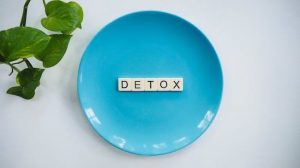Expertise, Food, Holistic Beauty, Recipes
Detox in spring - pleasant and gentle

May
Spring fatigue often overcomes us in spring - a sign that the body is struggling with waste products and deposits that drain its energy and make us sluggish. A gentle detox treatment helps the body to eliminate all harmful substances and gives us strength and new energy. Into spring, yay!
The basic steps to detoxification
The best way to start the day is with a large glass of warm lemon water. This boosts the metabolism and helps the body to become more alkaline. Lemon can also neutralise toxins and thus improve the appearance of the skin. Ideally, you should drink at least 2-3 litres of still water and unsweetened herbal teas (e.g. nettle, dandelion or milk thistle) during the day. This ensures that the body gets enough fluid and the herbs help the body to bind waste products and excrete them better. The intestines - and therefore the whole body - are also detoxified and cleansed.
To intensively support detoxification, you can take an alkaline bath 1-2 times a week. How to do it: Stir 1 tablespoon of baking soda or 1kg of sea salt into a full bath and relax for at least 30 minutes at a water temperature of 36 degrees. It is surprising how intensively the body can detoxify through the skin, and it is quite possible that you will be tired and downright exhausted after this bath. The treatment is therefore particularly recommended in the evening - and afterwards you can slip straight into a warm bed and let your body recover.
It is also important to do a little sport every day. A few minutes of yoga, a brisk walk or even cycling to the office are enough to stimulate the metabolism. This helps the body to detoxify and, practically speaking, to burn more calories.
These simple methods restore the alkaline-acid balance in the body.
f
fFasting "light"
If you have an intensive work schedule, a lot of travelling or other plans that make an ideal gentle detox cure impossible, you can bring your body back into balance through light fasting. You should avoid animal products (meat, dairy products, eggs, etc.), alcohol, sweets, ready meals and white flour products for 2-3 weeks. During this time, the body is happy to eat fruit, vegetables, cereals and wholemeal products. This diet does not strain the body and the intestines have time to recover. What's more, you hardly have to hold back on the amount you eat, as fresh vegetables, fruit and wholegrain products are good for you, support digestion with their fibre and make you feel full - so you automatically consume fewer calories than before!
The intensive variant: juice fasting
Juice fasting can be done as a 1 to 3-day short programme. On the evening before the juice fast, a teaspoon of Glauber's salt should be dissolved in a glass of water and drunk to pre-cleanse the intestines. During the fasting days, you should then completely abstain from solid food and eat freshly squeezed fruit and vegetable juices - organically grown, of course!
Good juice variations are, for example, apple, apple-carrot, apple-celery, carrot-beetroot or this "vegetable drink": boil 1 cup of carrots, 1 cup of cabbage, 1 cup of onion, 1 cup of pumpkin or kohlrabi with 4 times as much water for approx. 30 minutes (note, prepare without salt for a fasting cure!), drain and drink the broth.
Regardless of which liquid you choose (fresh juices, herbal tea or water), you should drink around 3 litres throughout the day to remove toxins from the body.
b

d
Insider tips
These two miracle products support the body during fasting and help you to persevere:
UmeboshiThe fruit of the ume tree preserved in salt and shiso leaves. Use in the form of a paste instead of salt as a seasoning or pour approx. 1 litre of warm water over the whole fruit, leave to infuse, drink and eat. It has a generally strengthening, strongly alkalising effect (also against hangovers after too much alcohol) and normalises digestion.
WheatgrassAs freshly squeezed juice or in tablet form. Increases vitality, strengthens the immune system, purifies the digestive tract and is a real miracle cure for skin, hair and nails thanks to its extremely high mineral and vitamin content!
d

Umeboshi fruit
f
For those who need solid food
Not everyone can simply do without solid food: Circulatory problems, an upcoming climbing tour or strongly fluctuating blood sugar levels sometimes make it difficult, hard, or even impossible to give up solid food completely in everyday life. In this case, you can eat wholegrain rice during the 1-3 day cure: Prepare it without salt and fat, but add a few diced carrots instead.
You made it! ...and now?
Anyone who has ever taken a cure knows the feeling: you feel fresh and full of energy, a little lighter and proud to have stuck it out. But what happens afterwards? Eating roast pork & co. again straight away for the sheer joy of having made it is - guess what - not ideal. It's best to start with a light, vegetarian diet - and who knows, maybe you'll take this opportunity to change your diet in a healthy direction...?
s

From nutrition expert Zsuzsanna Groggyer
Picture of the umeboshi fruit by photographer "oya" https://www.flickr.com/photos/oya/
Link to the picture: https://www.flickr.com/photos/oya/29633445/